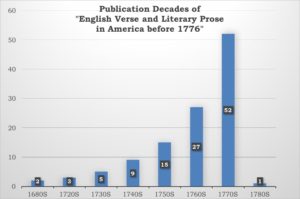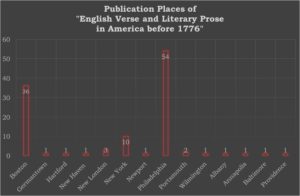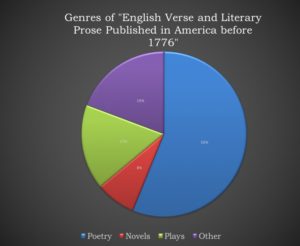In 1956, Edward Connery Lathem (1926-2009), who would later distinguish himself as a Robert Frost scholar, took leave from his position as director of the Division of Special Collections at Dartmouth College to pursue an advanced degree under renowned Jonathan Swift scholar Herbert Davis at Oxford University. There, Lathem completed his bibliography of “English Verse and Literary Prose in America before 1776,” and for almost fifty years this work reached very few U.S. scholars as it existed only on deposit at the Bodleian and British Libraries. At the urging of former AAS President Marcus McCorison, Lathem agreed in 2002 to allow the Society to publish this bibliography as a CD-Rom, with an introduction by McCorison, who had known Lathem since their days together at Dartmouth. Though McCorison makes much reference to the fifty-page introduction Lathem wrote, it is omitted from the 2002 publication. Recently, AAS catalogers have added citations of Lathem numbers to the North American Imprints Program (NAIP) catalog records. These citations had me returning to Lathem with a fresh set of questions. Thanks to our friends across the Atlantic,* AAS now has a copy of Lathem’s introduction on file, and I consulted it in the hopes of better understanding how Letham defined “literary prose” as such genre terms are always vexed.
Unfortunately, Lathem offers no clear-cut definition of “literature” and seems to assume that, like pornography, it might be hard to define, but readers will know when they see it. Lathem does assert that contrary to conceived notions, the colonists were not only interested in religious texts. “[I]t is clear,” Lathem writes, “that, in addition to their other book purchases, the colonists bought and read works of literature—literature good, bad, and indifferent—and quite apparently they did so in substantial quantity” (7). After briefly recounting the details of the importation of English literature and verse, Lathem turns to book production—both the limitations on it in distant colonies like America and the resulting “cheap reprint editions.” Though unauthorized reprinting so far away could never catch the opprobrium that Irish, and to some extent Scottish, publishers were plagued with, Lathem’s work here is especially illuminating in that, whenever possible, he traces the copy texts on which the American editions were based. A number of these were Irish and Scottish editions. And even if they were not, the colonial markets were arguably as culpable as the Irish of reproducing unauthorized English editions. Lathem explains, “Mention has been made of piracies, and in extension of this it must be frankly affirmed that the American literary editions of the colonial era were themselves of that sort, with but few possible exceptions” (37). “Even a political Loyalist,” Lathem continues, “like the New York printer James Rivington quite evidently felt no qualms of ethical or legal restraint about producing such editions or trafficing [sic] in Irish piracies” (38-39). Lathem offers three reasons why neither ethical scruples nor legal restrictions thwarted this practice: Irish and Scottish reprint editions were cheaper; the American colonies were increasingly boycotting English goods post 1765; and finally, many of the printers themselves were immigrants. These transatlantic networks can be further traced in the Printers’ File digital project underway here at AAS. But, for now, let’s focus on the books and their descriptions, first in Lathem’s bibliography and then in our union catalog.
As I have written about in more general terms previously, the North American Imprints Program (NAIP), a comprehensive catalog of books, pamphlets, and broadsides before 1820, offers us a chance to turn Lathem’s bibliography into data that we can analyze. As mentioned above, AAS catalogers have recently added Lathem numbers to NAIP, and we can now pull out records that have Lathem citations. This is not to suggest, however, that there is a direct relationship between NAIP and Lathem. In fact, there are 218 entries in Lathem, and 122 of these could be matched with a NAIP record. The remainder—96 of the Lathem entries—could not be matched with a record because, as he notes throughout his bibliography, “no copy is known.” Many of these are what bibliographers refer to as “ghosts”; that is, they are books that never actually existed, but for which bibliographers have made erroneous entries. Lathem frankly describes the possibility of such unknowns as “One of the most annoying of the bibliographer’s problems” (40) given how difficult it is to take a “conclusive stand” (41). Some of Lathem’s ghosts have been laid to rest, so that if he were doing this work fifty years later, he would not have included them in his bibliography. Other entries describe books that may in fact have existed, but for which there is no known extant copy; NAIP creates entries only for titles for which at least one copy is known to exist. On the other hand, there were seven imprints that Lathem could not identify that since 1961, have been identified and are in NAIP. These include: Richard Cumberland’s plays, The Fashionable Lover (1773) and The West Indian (1772); Robert Dodsley’s The Art of Preaching (1762); Robert Hitchcock’s The Macaroni (1774); George Alexander Stevens’s The Celebrated Lecture on Heads (not after 1775); John Taylor’s Verbum Sempiternum (ca. 1774); and Isaac Watt’s A Wonderful Dream (1785?), about which I’ll say more in a moment. The other discrepancy that occurs when Lathem numbers are entered in the NAIP records is one of de-duplication: a single record might cite more than one Lathem number because Lathem erroneously identifies two different editions we now know to be a single edition and therefore are described in a single NAIP record.
From the Lathem bibliography then, 114 NAIP records have been changed. By extracting the Machine Readable Catalog Records (MARC) from NAIP and converting them into a spreadsheet, we can begin to analyze Lathem’s data, and perhaps the production of early American literature, in new ways. Here, for example is a look at the progression of publication in these decades:

The rate of publication increases with time, as we might expect, but note the outlier: there appears to be a publication from the 1780s, at least four years after Lathem’s end date of 1776. The imprint in question is the aforementioned A Wonderful Dream by Isaac Watts. The NAIP record tells us that according to Hazel Johnson’s Checklist of New London, Connecticut, Imprints, 1709-1800, the book was most likely printed in 1785, not in 1766 as Lathem supposes in entry 211, or in 1770 as he supposes in entry 214. Johnson’s Checklist was published sixteen years after Lathem completed his work, and so the discrepancy between Lathem and NAIP, or put another way, between Lathem and the data, reveals an important bibliographic revision that has taken place since Lathem completed his work. It is worth noting that Roger P. Bristol’s Evans’ American Bibliography: Supplement would not be completed until a year after Lathem’s dissertation, and so Bristol’s updates are also missing.
The places of publication of early American verse and literary prose have no such outliers, but they do invite a new set of questions:

Why, for example, does Philadelphia so significantly outweigh the other cities? Sure, it was a publishing hub in its day, but so were Boston and New York. What was going on in Philadelphia that made it such a comparative hotbed of literary production? The answer, when one looks into the NAIP records and/or Lathem’s bibliography, is quite simple: Robert Bell, Scottish emigre by way of Dublin, who reproduced and sold literary works with a frequency, if not to say fervor, as yet unknown in the colonial markets. Bell was also unique in that his reprinting focused, though was not entirely limited to, plays. Most other reprints were of poetry, as this breakdown of genre illustrates.

Of the 114 records, NAIP identifies 64 poems or collections of poems, 9 novels, 19 plays, and 22 “other.” These others include multiple editions of John Bunyan’s Pilgrim’s Progress, Isaac Watts’s Hymnal, and satires including George Alexander Stevens’s Lecture on Heads (1767).
Please find the spreadsheet of NAIP records with Lathem numbers here. You can download it to see how I came up with these charts and to ask different questions of the data.** It is also worth noting that NAIP contains references to over one hundred other bibliographies, which can be found by searching “Bibliography Citation Keyword” in the General Catalog keyword search.
*I would like to thank Giles Bergel in particular for his help securing a copy of the Lathem Introduction.
**Genres are not included in the spreadsheet because, as I have presented elsewhere, extracting genre from catalog records is not a straightforward matter. The basic genre terms I use for figure 3 were added after the catalog record data pull.

One thought on “Running the Numbers on Early American Literature”